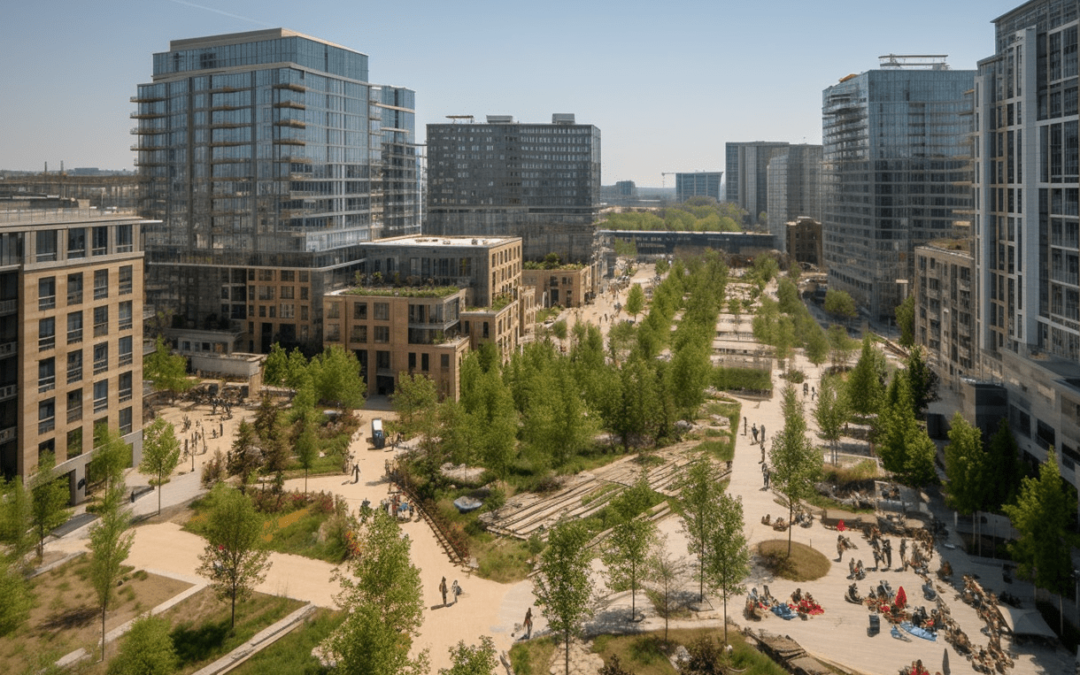What defines sustainable cities? I don’t know if there is an official definition, but there are clues in our past. If you look at the current commercial real estate crisis in major cities, most don’t seem to have a sustainable ecosystem. Most developers may not see it that way. In a recent 60 Minutes interview, Jon Wertheim interviewed developer Marc Holiday who said, “One of the biggest societal problems we are facing right now, is work from home. I think that it’s bad for business. It’s bad for cities. It’s bad for people.” How’s that for some bad logic?
The office is a relatively new concept. It’s coming up on its 300th anniversary. I don’t think there is going to be a party. Before the creation of the office, the capital of Thailand (Ayutthaya) was the world’s largest city at the time with over 1,000,000 people. It was described as the most beautiful city in the world – and not one office building. Further back in time Alexandria, Rome, Baghdad, and Babylon also reached the million person mark. And again, no office buildings.
Naturally, there was trade for certain specialty items, but for the most part, cities were sustainable. They had an economy built around shared needs. Bakers, farmers, weavers, and blacksmiths all worked in sync with one another. Some artists, artisans, and performers traveled, but for the most part, a city had what it needed to survive. Many cities withstood invasions for long periods because they had everything they needed. With our recent pandemic, people lost their minds over toilet paper, paper towels, and baby formula when supply chains were disrupted. We’ve lost the element of sustainability.
Profit through Specialization
Specialization in most of its forms is more profitable than generalization. Surgeons make more than general practitioners. Making 1000 widgets is more profitable than making 10 widgets each of 100 different types. Henry Ford’s assembly line reduced costs and increased profitability. Putting 1000 people in one building is also more profitable than putting 10 people in 100 buildings.
This direction that gained momentum in the early 1900s got into full swing after World War 2. Little pink houses were cranked out at lightning speed to create the first suburb in 1947. This was a new model. All the houses were in one place, and you went somewhere else to work. It was efficient to build and most importantly, profitable. Thankfully we have cars to get you to and from work.
Back in the cities, urban renewal projects were replacing depressed neighborhoods with central business districts with shiny new high-rise buildings. It was the American dream that came to life. Slaughterhouses and other unpleasant businesses were moved out of the cities and centralized in the Midwest. Industries such as automakers, bakers, canneries, dairies, and other businesses consolidated as well. Proximity was replaced by reliable supply chains and a nationwide highway system. It was a great system until it started to break. Throw in a nasty virus, and all of the interdependent systems start to break down. We have gotten so good and extracting the most efficiency and profit out of various systems, that we have lost sight of their resiliency. In many cases, our cities, companies, and lives are not resilient or sustainable. It’s worse in North America because we don’t have any existing boundaries to work within. The limits of all systems got stretched further than elsewhere. European, Asian, and South American cities are typically older and generally have remnants of their sustainable days a few centuries ago.
Going Forward to the Past
No this is not a variation of Back to the Future. Somewhere along the lines, we sacrificed sustainability for profitability. We got away with it for decades, but eventually the elastic snapped. It’s easy for commercial real estate owners to blame remote work for their demise, but it’s like blaming a pin for popping a balloon. The balloon was always in danger because it wasn’t designed to handle a change in its environment. If the balloon was more resilient it would be less of an issue. Now to make a more resilient balloon, it may no longer be a balloon as we know it. Central business districts are like balloons. To make them more sustainable, we need to go back to the models we had before WW2.
Most older cities had polycentric designs. There were districts that each had shops, apartments, parks, offices, doctors, etc. Some specialty businesses warranted traveling across town, but for the most part, they were sustainable neighborhoods. Even our suburban model is not sustainable because it’s single-use.
Short-term profits are often wiped out when the supply chain breaks. In the long term, sustainability is more profitable but we need to adopt that view of the world. We need to look at how communities worked before 1700 to get clues to improve our sustainability. The principles are pretty simple:
- Mixed use of land
- Local production of resources where possible
- Don’t over-specialize or over centralize production of anything requiring a supply chain
- Don’t overbuild
- Work in cooperation with nature
Many developers and CEOs are still holding on to the idea of, “if we only bring people back to the office”. That ship has sailed. The longer they hold on, the worse it is going to get. With the CRE loans that are due in the next two years, cities need a new plan fast. We just need to turn back the clocks a bit to get a glimpse of where we want to go in the future.



